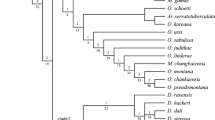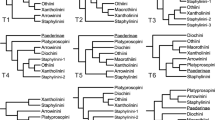Abstract
We present the results of a combined analysis of 248 morphological characters and sequences from 3 genes for 29 species of Xeromelissinae and 7 outgroup taxa including representatives of the colletid subfamilies Colletinae, Euryglossinae, Hylaeinae, Paracolletinae, and Scrapterinae. The paracolletine genus Trichocolletes was used to root the tree. The results agree with most of those obtained in an earlier, entirely morphological analysis. Noteworthy are (1) the paraphyly of Chilimelissa in relation to Xeromelissa, and (2) the lack of sister group relationship between Hylaeinae and Xeromelissinae. Other than minor rearrangements resulting from swapping adjacent nodes, the only major difference is the placement of one species of Chilicola, C. aenigma, which no longer groups within C. (Chilioediscelis), but instead appears to be closer to Xenochilicola. The influence upon phylogenetic results caused by highly morphologically autapomorphic taxa is discussed.
Zusammenfassung
Die Xeromelissinae bilden eine Subfamilie der Colletidae. Sie umfasst etwa 200 Art mittelgrosser Bienen, die in ihrer Verbreitung alle auf die Neue Welt bechränkt sind. Wie der Namen bereits besagt, handelt es sich hierbei um Bienen, die im allgemeinen in Trockenhabitaten vorkommen, vor allem im südlichen Südamerika. Xeromelissinen sind typischerweise klein bis sehr klein und im allgemeinen von schlanker Gestalt. In der vorliegenden Arbeit präsentieren wir die Ergebnisse einer kombinierten Analyse von 248 morphologischen Merkmalen und den Sequenzen von drei Genen. Die Analyse umfasst 29 Arten, die alle Genera der Xeromelissinae repräsentieren, sowie 7 Taxa mit Vertretern der Colletiden-Subfamilien Colletinae, Euryglossinae, Hylaeinae, Paracolletinae und Scrapterinae als Aussengruppen. Der molekulare Datensatz bestand aus den Sequenzen von zwei Kerngenen (Elongationsfaktor 1 alpha (F2-Kopie) und 28S rRNA) und einem mitochondrialen Gen (Cytochromoxidase 1). Die Wurzel des Stammbaums wurde mithilfe der Merkmale des Genus Trichocolletes (Paracolletinae) definiert. Die Ergebnisse stimmen in den meisten Punkten mit den Befunden einer früheren Analyse überein. Bemerkenswert sind (1) die Paraphylie von Chilimelissa in Bezug zu Xeromelissa und (2) das Fehlen einer Schwestergruppenbeziehung zwischen Hylaeinae und Xeromelissinae. Ausser kleineren Veränderungen in der Stammbaumtopologie, die aus der Verschiebung benachbarter Knotenpunkte herrühten, lag der einzige grössere Unterschied in der Positionierung einer Art des Genus Chilicola, C. aenigma. Diese gruppierte nicht mehr innerhalb von C. (Chilioediscelis), sondern erschien enger verwandt mit Xenochilicola. Neben diesen Ergebnissen diskutieren wir den Einfluss von morphologisch stark autapomorphen Taxa mit wenigen gemeinsamen Merkmalen auf die phylogenetischen Beziehungen mit anderweitig weniger aussergewöhnlichen Arten.
Similar content being viewed by others
References
Almeida E.A.B. (2007) Systematics and Biogeography of Colletidae (Hymenoptera: Apoidea), unpublished PhD Dissertation, Cornell University, Ithaca.
Altekar G., Dwarkadas S., Huelsenbeck J.P., Ronquist F. (2004) Parallel Metropolis-coupled Markov chain Monte Carlo for Bayesian phylogenetic inference, Bioinformatics 20, 407–415.
Beishaw R., Quicke D.L.J. (1997) A molecular phylogeny of the Aphidiinae (Hymenoptera: Braconidae), Mol. Phylogenet. Evol. 7, 281–293.
Bergsten J. (2005) A review of long-branch attraction, Cladistics 21, 163–193.
Danforth B.N. (1999) Phylogeny of the bee genus Lasioglossum (Hymenoptera: Halictidae) based on mitochondrial cytochrome oxidase, Syst. Entomol. 24, 377–393.
Danforth B.N., Sauquet H., Packer L. (1999) Phylogeny of the bee genus Halictus (Hymenoptera: Halictidae), based on parsimony and likelihood analyses of nuclear EF-1α sequence data, Mol. Phylogenet. Evol. 13, 605–618.
Danforth B.N., Brady S.G., Sipes S.D., Pearson A. (2004) Single-copy nuclear genes recover Cretaceous-age divergences in bees, Syst. Biol. 55, 309–326.
Danforth B.N., Fang J., Sipes S. (2006a) Analysis of family-level relationships in bees (Hymenoptera: Apiformes) using 28S and two previously unexplored nuclear genes: CAD and RNA polymerase II, Mol. Phylogenet. Evol. 39, 358–372.
Danforth B.N., Sipes S., Fang J., Brady S.G. (2006b) The history of early bee diversification based on five genes plus morphology, Proc. Natl. Acad. Sci. USA 103, 15118–15123
Doyle J.J., Doyle J.L. (1990) A rapid total DNA preparation procedure for fresh plant tissue, Focus 12, 13–15.
Engel M.S. (2005) Family-group names for bees (Hymenoptera: Apoidea), Am. Mus. Novit. 3476, 1–33.
Farris J.S. (1989) The retention index and the rescaled consistency index, Cladistics 5, 417–419.
Folmer O., Black M., Hoeh W., Lutz R., Vrijenhoek R. (1994) DNA primers for amplification of mitochondrial cytochrome coxidase subunit I from diverse metazoan invertebrates, Mol. Mar. Biol. Biotechnol. 3, 294–299.
Goloboff P.A., Farris J.S., Källersjö M., Oxelman B., Ramırez M.J., Szumik C.A. (2003) Improvements to resampling measures of group support, Cladistics 19, 324–332.
Goloboff P.A., Farris J.S., Nixon K.C. (2004) TNT: Tree analysis using new technology, computer program distributed by the authors at http://www.zmuc.dk/public/phylogeny/TNT/ (accessed on 8 November 2007).
Huelsenbeck J.P., Ronquist F. (2005) MRBAYES: Bayesian inference of phylogeny, Bioinformatics 17, 754–755.
Maddison D.R., Maddison W.P. (2005) MacClade 4.08. Sinauer Associates, Sunderland.
Mardulyn P., Whitfield J.B. (1999) Phylogenetic signal in the COI, 16S, and 28S genes for inferring relationships among genera of microgastrinae (Hymenoptera: Braconidae): Evidence of a high diversification rate in this group of parasitoids, Mol. Phylogenet. Evol. 12, 282–294.
Michener C.D. (1995) A classification of the bees of the subfamily Xeromelissinae, J. Kans. Entomol. Soc. 68, 332–345.
Michener C.D. (2000) The Bees of the World, John Hopkins University Press, Baltimore.
Michener C.D., Rozen J.G. Jr. (1999) A new ground-nesting genus of Xeromelissine bee from Argentina and the tribal classification of the subfamily (Hymenoptera: Colletidae), Am. Mus. Novit. 3281, 1–10.
Minin V., Abdo Z., Joyce P., Sullivan J. (2003) Performance-based selection of likelihood models for phylogeny estimation, Syst. Biol. 52, 674–683.
Morgenstern B. (1999) DIALIGN 2: improvement of the segment-to-segment approach to multiple sequence alignment, Bioinformatics 15, 211–218.
Nixon K.C. (2002) WINCLADA v.1.00.08, computer program distributed by the author at http://www.cladistics.com/wincDownload.htm (accessed on 8 November 2007).
Nylander J.A.A. (2004) MrAIC.pl. Computer program distributed by the author at: http://www.abc.se/~nylander/mraic/MrAIC143.tgz (accessed on 8 November 2007).
Packer L. (2008) Phylogeny and classification of the Xeromelissinae (Hymenoptera: Apoidea, Colletidae) with special emphasis upon the genus Chilicola, Syst. Entomol., 33, 72–96. [Published article online: 6 September, 2007: doi: 10.1111/j.1365-3113.2007.00398.x].
Schulmeister S., Wheeler W.C., Carpenter J.M. (2004) Simultaneous analysis of the basal lineages of Hymenoptera (Insecta) using sensitivity analysis, Cladistics 18, 455–484.
Toro H., Moldenke A. (1979) Revisión de los Xeromelissinae Chilenos, An. Mus. Hist. Natur., Valparaiso 12, 95–182.
Ward P.S., Brady S.G. (2003) Phylogeny and biogeography of the ant subfamily Myrmeciinae (Hymenoptera: Formicidae), Invertebr. Syst. 17, 361–386.
References
Ascher J.S., Engel M.S. (2006) On the availability of family-group names based on Scrapter (Hymenoptera: Colletidae), Entomol. News 117, 117–119.
ICZN (1999) International Code of Zoological Nomenclature, 4th Ed., International Trust for Zoological Nomenclature, London.
Engel M.S. (2005) Family-group names for bees (Hymenoptera: Apoidea), Am. Mus. Novit. 3476, 1–33.
Melo G.A.R., Gonçalves R.B. (2005) Revised bee classifications (Hymenoptera, Apoidea, Apidae sensu lato), Rev. Bras. Zool. 22, 153–159.
Michener C.D. (1989) Classification of American Colletinae (Hymenoptera, Apoidea), Univ. Kans. Sci. Bull. 53, 622–703.
Michener C.D. (2000) The Bees of the World, John Hopkins University Press, Baltimore.
Author information
Authors and Affiliations
Corresponding author
Additional information
Manuscript editor: Bryan Danforth
Rights and permissions
About this article
Cite this article
Almeida, E.A.B., Packer, L. & Danforth, B.N. Phylogeny of the Xeromelissinae (Hymenoptera: Colletidae) Based upon Morphology and Molecules. Apidologie 39, 75–85 (2008). https://doi.org/10.1051/apido:2007063
Received:
Revised:
Accepted:
Issue Date:
DOI: https://doi.org/10.1051/apido:2007063




